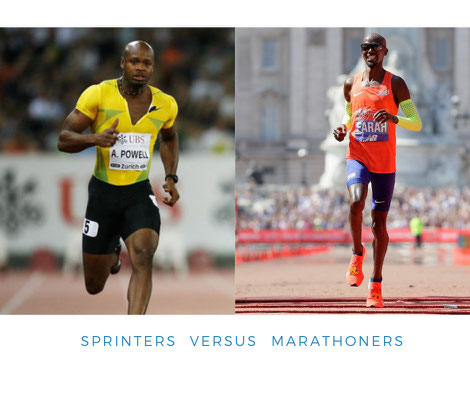We don't necessarily advocate hard core body building as the healthiest pursuit in the world but there's nothing wrong with wanting a better body and the extra confidence that comes with it. I mean who doesn't want to look good naked? And if that extra confidence brings with it an increased desire to pay more attention to diet, exercise, sleep, stress management and other healthy lifestyle changes then that can only be a good thing. And even if you are into extreme bodybuilding then if you're going to do it then at least do it properly. As a caveat, and just to be clear, there is a HUGE difference between body building and strength training but we'll save that for another day! So this article is for those of you who are either (a) already engaging in a body sculpting programme and failing to get the results you desire and (b) those who are thinking of getting into it.
1. Training
Wrong training variables

As you may already know, resistance training is the best way to build muscle as well as lose fat. But if your program is not built around the appropriate training variables, you will never get the results you want. To induce a change in muscle size, or hypertrophy, you need a trigger. You will need to stress your body enough to trigger it to create larger and stronger muscles. The best trigger for this adaptation is to lift loads heavy enough to recruit the majority of muscle fibers and to maintain their stimulation over a specific period of time. More specifically, you will need to train in the medium repetition range, or body building zone of 8 to 12 repetitions, and lift loads around 70-85% of your 1 RM (One Repetition Maximum, the maximum amount of weight you can lift one time for a given exercise). In addition, research shows that programs focusing on higher loads and volume, as well as shorter rest periods cause the biggest response in growth hormone production, anabolic by nature that are necessary to get muscle cells to increase in size. Lifting light loads for long sets will only help you develop Type I muscle fibers responsible for muscular endurance, the ability for muscles to produce contractions for an extended period of time. For instance, muscular endurance is required for sports like marathons or long-distance running. But focusing on shorter reps and higher loads will develop the Type II muscle fibers, capable of exerting strength and power, and have a higher potential for muscle hypertrophy. So in summary, if you usually spend most of your time in the gym lifting relatively light loads for sets of 15 to 20 repetitions or more, you might want to review your training program.
Not training enough

Another important factor in building lean muscle mass is volume and frequency. Frequency of training is defined as the number of training sessions per week. And for hypertrophy, you will need high volume, and as a result, high frequency. Generally, for most people, training a muscle group twice a week should be enough. If you follow a split program, where you divide your training sessions by body parts, it means that you will need to perform back exercises, or leg exercises twice a week for example.
This does therefore mean that going to the gym twice a week just won't cut it if you are looking to create the body of your dreams. If you split your program between legs, chest, and back, you will need to train 5 or 6 times a week (with appropriate rest) to reach the necessary volume. Take note that if you’re a beginner, don’t start training 6 days a week right away, it would be a recipe for disaster. You need to build up your training frequency over time. You'll need to start with a full body program 3 times a week for a few months before you can increase your training frequency up to 6 days a week.
No periodisation (i.e. not changing the program every 4 to 6 weeks)

Now, you are following the right training variables and frequency, but after a few weeks, you feel like you’re not progressing anymore: you’ve reached a plateau. Why? The body, in order to survive, is always trying to remain in a state of homeostasis, this is an innate tendency for the biological systems in our bodies to maintain steady internal conditions. Simply put, the body will always adapt to any stress put upon it in order to get back to a balanced state. Training is a type of stress that will force the body to adapt. At first, the body and muscles will get broken down as a result of a new exercise program. But following a period of recovery, the body will then “supercompensate”, and adapt in order to be able to handle the same training with ease and in a more energy-efficient way. This adaptive response is called supercompensation and leads to increased endurance, strength and power. But if no new training stress is applied to the body after that, there will be a decline, known as the detraining phenomenon. Not only will you not progress, but you might even lose the gains from your previous training. But this phenomenon can be avoided as long as new stress is applied to the body on a regular basis. This is why the training variables in your program need to change regularly in order to keep challenging the body. In general, it is agreed that training programs should be modified every 4 to 6 weeks in order to keep progressing and avoid plateaus.
If this all seems a little daunting from a DIY perspective then check out our article on how to select a personal trainer to help you out.
2. Diet

You can’t put on muscle if you’re not providing your body with the right fuel and you can’t lose fat if you’re consuming too much sugar. Diet is probably the number 1 thing that people get wrong when it comes to looking good and getting toned: protein shakes, supplements, refined carbs, sugar, protein bars, commercial milk, caffeine, soy products, alcohol: all total garbage. You need good quality animal or fish protein to build muscle, carbs and fat for energy and plenty of vegetables to provide the micronutrients required to glue everything together. If you look at the old school strong men like Eugen Sandow they were obsessed with diet, looked ripped and were exceedingly strong. A typical plate of theirs would contain grass fed meat with the fat/wild fish/eggs, organic veggies and tubers - rinse and repeat, 3 times a day.
Not eating enough is also a big problem. You need to provide yourself with enough fuel so that you have the resources on board to build the body you desire. The more intensive your workout, the more muscle you breakdown, the more you’ll need to repair the damage done. Of course there’s a fine line here and overeating will of course result in fat accumulation. Which is why body builders like to cycle in and out of “cutting” and “bulking” phases. It doesn’t have to be that way though. Work out what your Primal Pattern Diet TypeTM is, eat right for your metabolic needs, stop eating when you’re full and it is possible to add muscle and lose fat at the same time.
A great place to start researching diet is the first part of our article on organic food in Singapore and whether it's worth it or not.
3. Sleep
You don’t put on an ounce of muscle whilst you’re awake. Training breaks down muscle and sends a signal to your body to repair it. If your body has enough resources on board, and the repair time available, then it will repair it stronger and bigger! When is that repair time? That’s right, when you sleep. Studying the circadian rhythm in detail reveals that the body physically repairs itself between the hours of 10pm and 2am. Mental repair occurs between 2am and 6am. So if you want to build maximum muscle get to bed early. Ideally you want to be asleep before 10pm. This is even more so important if your training frequency is high without recovery days in between sessions – you need to fully recover every night before the next day's training session.
Secondly you want to ensure the quality of your sleep is good. Late night sugary snacks, training in the evening, caffeine after lunch and stress (see below) will all result in an unfavourable cortisol response (i.e. too much too late) which will impede your ability to get a good night’s rest. Check out our article here to find out how to get a perfect night's sleep.
|
Did you know High cortisol = fat storage mode! It is the enemy of muscle building and fat loss. When your cortisol levels are high your body thinks it’s in a war zone and that food is scare so it must “helpfully” switch off non critical bodily functions, conserve energy and store fat. In addition cortisol will break down muscle tissue to convert it into glucose (a process well known by those in the paleo/low carb/keto crowd as gluconeogenesis), the absolute antithesis of what bodybuilding is trying to achieve! |
||
4. Stress
Stress is a major saboteur when it comes to cannibalising your exercise regime and the body of your dreams. Our bodies’ deal with physical, emotional and mental stress in exactly the same way. They are all poured into the same metabolic “stress bucket” that results in high cortisol (see the did you know sidebar above). Just got shouted at by your boss? Argument with the wife? Bitchy comment on Facebook stressing you out? Had a couple of coffees and a few beers today? Still bothered over unpleasant incidents that happened in your past life? Going for a 10km run? All this will trigger the same response -> high cortisol. So what does it do? Well one of its functions is to breakdown muscle tissue to turn it into glucose to use as an emergency fuel source. Very handy if you’re running away from a tiger but not so useful when you’re having an argument with one of your work colleagues! So not managing your stress levels will ensure that you are breaking down the muscle that you want to grow and creating excess sugar that will just end up being converted into fat.
Wrapping Up
Exercise, diet, sleep and stress are generally considered the 4 most important variables to manipulate to get the best results possible from a well designed bodybuilding programme. There are many others elements that will also contribute beneficially, and may actually be even more significant for you personally depending on how much you are ignoring these natural doctors! Namely sunlight and vitamin D, emotional wellbeing, having the correct mindset, being hydrated with and enough good quality water and avoiding external and internal environmental toxins. So as you can see getting the body you desire, and deserve, is not just about "pumping iron" but actually in a more well thought out and integrated holistic lifestyle programme.
To your health, happiness and longevity,
The Levitise Team
P.S. If you love this blog post then do check out our fortnightly newsletter where you'll get the freshest content on health, nutrition and fitness delivered straight to your inbox. Don't miss out and sign up here with just your name and email.

Write a comment